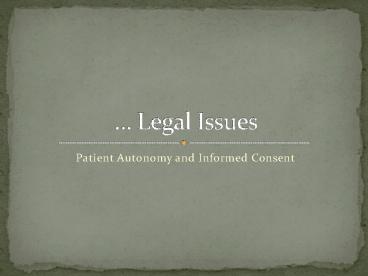Patient Autonomy and Informed Consent - PowerPoint PPT Presentation
Title:
Patient Autonomy and Informed Consent
Description:
Patient Autonomy and Informed Consent Begin reading at Law, p 82 (we covered the ethical issues in the Ethics text). Bottom of p 82 the book talks about these torts ... – PowerPoint PPT presentation
Number of Views:269
Avg rating:3.0/5.0
Title: Patient Autonomy and Informed Consent
1
Legal Issues
- Patient Autonomy and Informed Consent
2
Legal Issues
- Begin reading at Law, p 82 (we covered the
ethical issues in the Ethics text). - Bottom of p 82 the book talks about these torts
assault, battery, false imprisonment, negligence
with regard to lack of informed consent. - For a list of differences between torts and
crimes - http//www.earlham.edu/peters/courses/ct/crimtort
.htm
3
Legal Issues
- Definitions
- Tort a civil wrong for which the law provides a
remedy - Tort Action plaintiff filing to recover damages
for personal injury or property damage occurring
from negligent conduct or intentional misconduct
4
Torts
- For imaging professionals the following torts are
most common - Intentional Tort
- assault
- battery
- false imprisonment
- Defamation (for Ch. 5, on truthfulness)
- Unintentional Tort
- Negligence (covered in Ch. 2)
- failure to obtain informed consent
- breach of patient confidentiality (covered in Ch.
2)
5
Intentional Torts
- Intentional Torts
- Assault
- deliberate act which
- threatens harm to another person without consent,
and - victim perceives others ability to carry out
threat - Battery
- touching to which the other has not consented
- even if the touching may benefit other
6
Intentional Torts
- Intentional Torts
- Assault and Battery are a concern especially when
restraints are used in imaging - The book uses the term medical immobilization to
distinguish restraint with and without consent - Medical immobilization without consent is
restraint - When restraint is required, imaging professionals
should be able to justify it using the following
4 criteria
7
Intentional Torts
- Legal Criteria for Use of Restraint (from Box
4.4, top of p84) - Touching or restraining to which the patient has
not consented is needed to protect the patient,
health care members, or the property of others - The restraint used is the least intrusive method
possible - Regular reassessment of the need to restrain
occurs - The restraint is discontinued as soon as
practicable - When dealing with children, it would be important
to make parents aware that you are guided by
those criteria
8
Intentional Torts
- Law, p84
- False Imprisonment Unlawful confinement within
a fixed area - Confined must be aware of confinement
- Confined must be harmed by confinement
- The book says
- Even if the health care provider does not intend
harm, these allegations can be made if the
patient perceives the acts to be done with the
intent of harm. Law p 84 - Note that intent is not part of the definition of
false imprisonment above, and so the quotation
above doesnt make sense. Is intent to harm part
of false imprisonment or not? Google false
imprisonment law sites dont mention it in
their definitions.
9
Unintentional Torts
- Informed Consent
- Case law governing informed consent was
established in these 2 cases - 1952, Salgo v Leland Stanford Jr. University
Board of Trustees - 1972, Canterbury v Spence
- All 50 states now require informed consent
10
Informed Consent
- There are 2 exceptions to the requirement for
informed consent - Emergencies
- Therapeutic Privilege
11
Informed Consent
- In general, to prove lack of informed consent, a
plaintiff must show - A material risk existed that was unknown to the
patient - The risk was not disclosed
- Disclosure would have led a reasonable patient to
reject treatment or seek other course - Patient was injured by lack of disclosure
- Note that the details of your particular hospital
or clinic standard of care, local statutes,
professional standards, etc., will play a role in
determining disclosure requirements
12
Informed Consent
- Informed Consent Law
- 2 points
- Nearly all states impose the duty of obtaining
informed consent on physicians only - Some have tried to impose the duty on hospitals
- The book says imposing the duty to obtain
informed consent on hospitals has met with
limited success you should find out who has
that duty when you find a job
13
Informed Consent
- Read p 86,
- Pauscher v Iowa Methodist Medical Center
- (for an example of an informed consent action
that failed) - Keel v St. Elizabeth Medical Center
- (for an action that succeeded)
14
Informed Consent
- Review Elements of Informed Consent (p 87 Box
4-5) - Note the final element
- Consent to treat a minor patient is usually given
by a parent or guardian, but if the minor patient
is at least 7 years old, he or she should be
included in the decision-making process - That introduces the question of how to approach
children
15
Informed Consent
- On p 88, second paragraph, the book notes 2
concepts the American Academy of Pediatrics
recognizes regarding children - In most cases physicians have a moral and legal
duty to obtain parental permission to treat a
minor - In the case of emancipated minors (age 14 to 18,
legally not living with parent or guardian) or
mature minors with adequate decision-making
capacity, consent should be obtained directly
from patient































